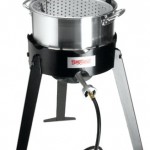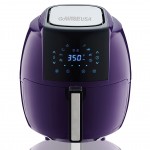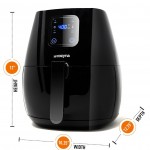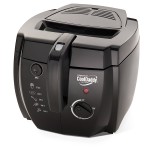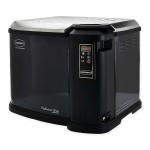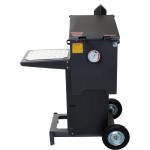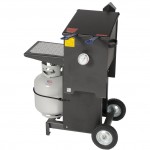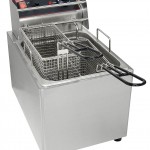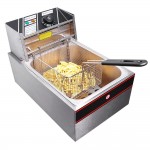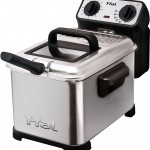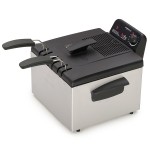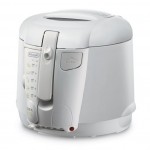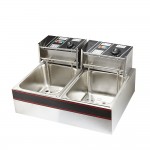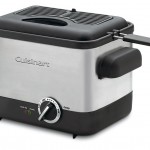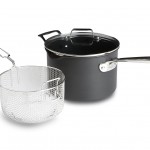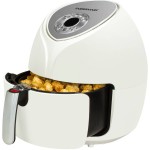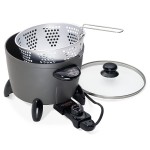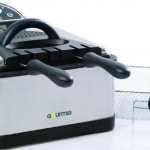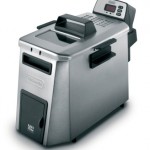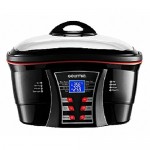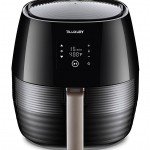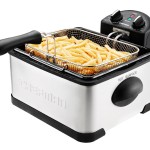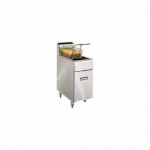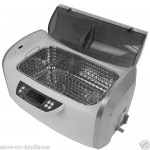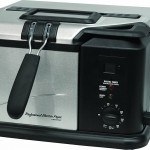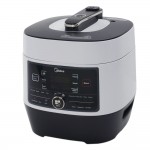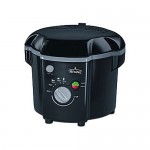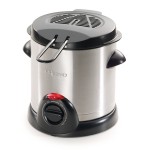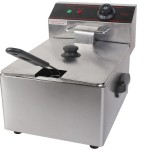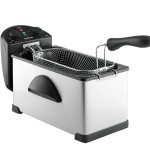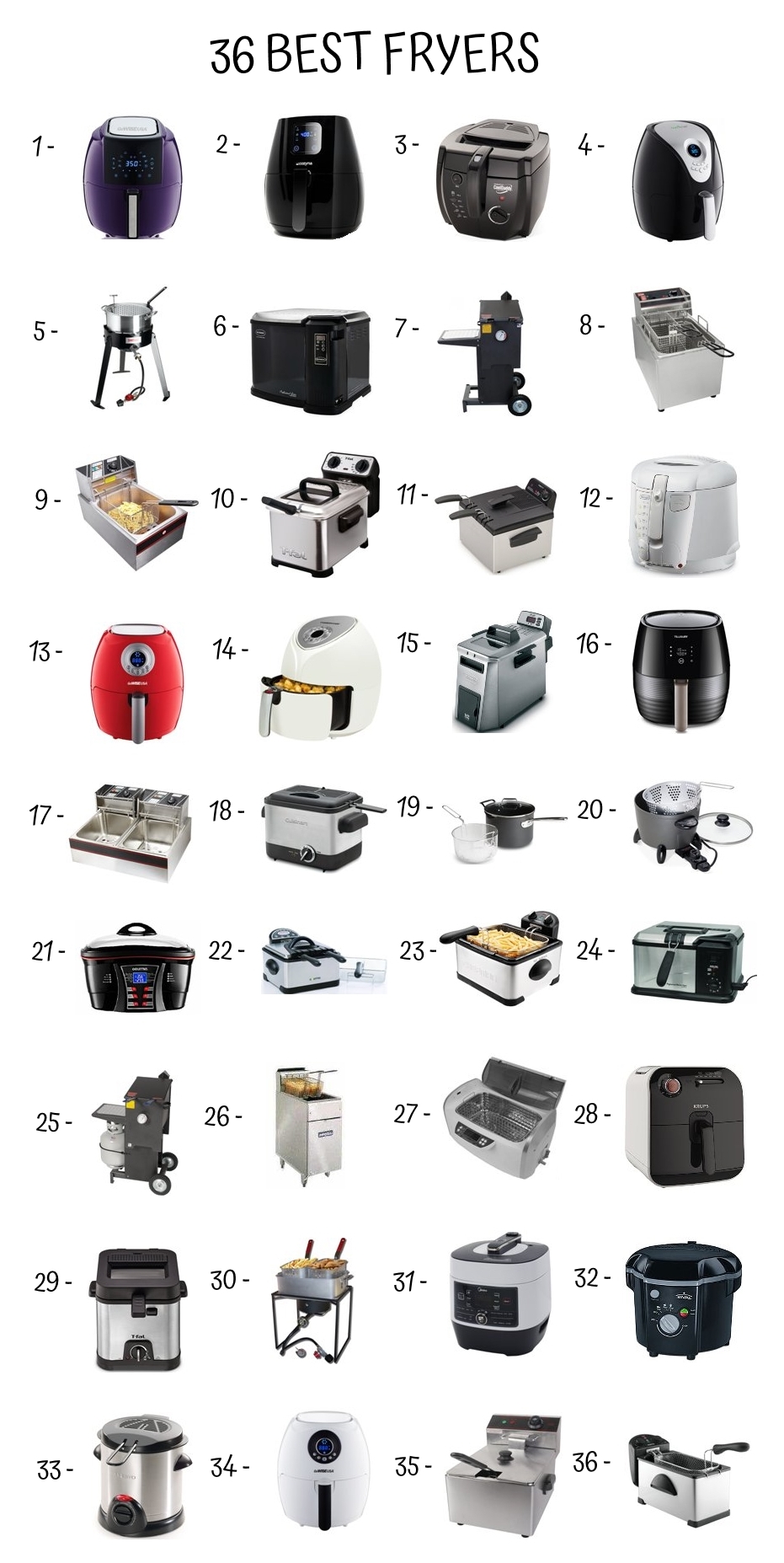
Take your time and read the fryer buying guide information just below. Alternatively, skip ahead by clicking on the following link, to see which models made it onto the best fryer top 36 list.
1) GoWISE USA 5.8-Quart Programmable 8-in-1 Air Fryer XL | 2) Air Fryer by Cozyna (3.7QT) with airfryer | 3) Presto 05442 CoolDaddy Cool-touch Deep Fryer | 4) NutriChef Electric Hot Air Fryer Oven w/ Digital Display | 5) Bayou Classic 2212 Aluminum Outdoor Fish Cooker Set | 6) Butterball XXL Digital 22 lb. Indoor Electric Turkey Fryer | 7) Cajun Fryer 4 Gallon Deep Fryer | 8) Grindmaster-Cecilware EL25 Countertop 2-Basket Electric Fryer | 9) 2500W 6 Liter Electric Countertop Deep Fryer | 10) T-fal FR4049 Family Pro Electric Deep Fryer | 11) Presto 05466 Dual Basket Pro Fry Immersion Element Deep Fryer | 12) DeLonghi D677UX 2-1/5-Pound-Capacity Deep Fryer | 13) GoWISE USA 2.75-Quart Digital Air Fryer | 14) 5L Fast Cooking Digital Temperature Control Air Fryer | 15) DeLonghi D24527DZ Dual Zone Deep Fryer | 16) Tiluxury PU-K02 Air Fryer | 17) Flexzion Deep Fryer Dual Tank 5000W | 18) Cuisinart CDF-100 Compact 1.1-Liter Deep Fryer | 19) Emeril Hard Anodized Nonstick Scratch Resistant Chicken Fryer Set | 20) Presto 06003 Options Electric Multi-Cooker/Steamer | 21) Gourmia GMC700 Supreme 8-in-1 Digital Multi-Function Cooker | 22) Gourmia GDF500 Compact Electric Deep Fryer | 23) Chefman Deep Fryer with Basket Strainer Perfect for Chicken | 24) Masterbuilt 20010610 Indoor Electric Fish Fryer | 25) Cajun Fryer 6 Gallon Deep Fryer | 26) Imperial Commercial Fryer Gas-Open Pot Stainless Steel | 27) ANGEL POS cd4860 300W 6 Liter 1.58 Gallon Ultrasonic Cleaner | 28) KRUPS AJ1000US Air Fryer Low-Fat | 29) T-fal FF492D Stainless Steel 1.2-Liter Mini Deep Fryer | 30) King Kooker 1618 16-Inch Propane Outdoor Cooker | 31) Midea MY-SS6062 Power 8-in-1 Pressure Cooker | 32) Rival CF106 1-Liter Deep Fryer | 33) Presto 05470 Stainless Steel Electric Deep Fryer | 34) GoWISE USA Electric Digital Air Fryer | 35) Giantex 2500w Deep Fryer | 36) Gourmia GDF300 Electric Restaurant Deep Fryer |
There are few things as satisfying as the crunch of a golden, fluffy fat-cut chip. And while we know deep frying adds fat to our food, it will always hold a special place in our culinary consciousness when we need a comforting meal.
Frying may look simple, but getting it right involves more than just chucking a battered fillet into a vat of hot oil. Undercooked food, soggy batter and third-degree burns are known to come with deep frying territory, but this doesn’t have to be the case.
This troubleshooting guide will help you fearlessly fry in no time.
Frying: The Good Oil
We know that deep frying is often the fastest way to cook, with most foods cooked in under five minutes. This makes it easy to prepare food to order, keeping waste to a minimum and imparting that unique feel-good flavour to food – cue the crunch of the batter, the creaminess of the inner core and the memories of your childhood summers.
Keep in mind, when oil is re-used, it becomes degraded and more of it is absorbed into food. Vegetable, canola and rice bran oils can be heated to much higher temperatures without burning (and are the recommended oils if you’re using a proper deep fryer).
What Happens in the Vat
The frying process occurs in four stages:
- Initial heating: The food surface heats to boiling point and moisture starts to evaporate turning into steam.
- Fat/oil transfer: As the food continues to heat up the moisture in the food turns to steam and works its way to the foods surface where it is seen as bubbles. The movement cause by the steam leaving the food repels the oil at the food’s surface and prevents it from diffusing into the food.
- Surface and crust formation: Crust begins to form in the first 60 seconds of the frying process sealing the food.
- Cooking the interior: the product’s internal core temperature rises effectively cooking the food. Food should be removed when few bubbles appear on the surface of the food.
Basic Rules for Deep Frying
There are a few basic rules for frying food correctly; the fryer should be filled to recommended levels, food should be prepared correctly and oil should be changed regularly. However, the real secret to becoming master of the deep fryer is to be vigilant about oil temperature.
The oil must be hot enough to seal the food so the fat doesn’t penetrate but not so hot that the exterior burns before the inside has a chance to cook. Using a thermometer is the easiest way to monitor and maintain a consistent temperature, even better if your electric deep fryer has an inbuilt thermostat.
Consider how much space your food is going to take up in the fryer and avoid overcrowding the vat. You need to leave room for the food to rise and heating too many items in the fryer will alter the cooking time.
Also be aware that food that is frozen or chilled will reduce the oil temperature, so try to fry foods from room temperature. When you’ve fried your food to perfection, remove it from the oil with a slotted spoon — don’t use tongs as they can pierce the crispy batter, allowing steam to escape.
The best way to drain fried items is with a paper towel to soak up the excess oil.
Finally, you need a plan for disposing of your oil. Dropping hot oil down the sink is not good for your pipes or the environment. If your restaurant goes through large amounts of frying oil, you’ll need to sort out a long-term solution, like organising for it to be collected and recycled.
